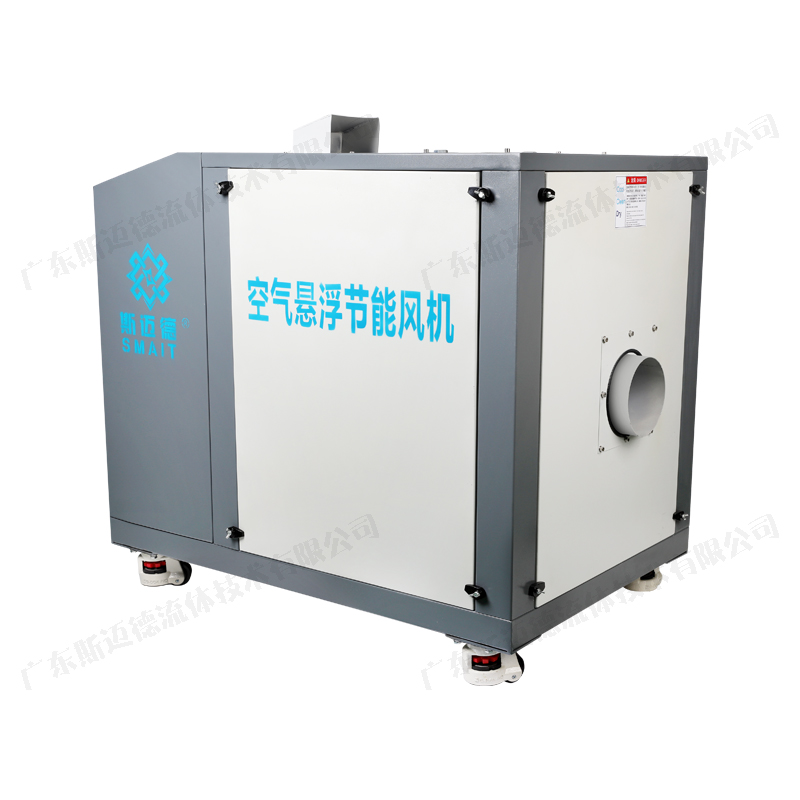SmedThe low energy consumption characteristics of air suspension fans are mainly achieved through various energy-saving measures such as air suspension technology, variable frequency speed regulation technology, and intelligent control systems. Under the joint action of these technologies, not only has the energy efficiency of the fan been improved, but the operating cost and maintenance difficulty have also been greatly reduced. The following is a detailed analysis of these technologies:

& nbsp; 1. Air suspension technology
& nbsp; By utilizing airflow to support the rotation of the wind turbine, the suspension effect is achieved, greatly reducing the frictional resistance of the fan. This non-contact suspension working principle avoids energy loss caused by mechanical friction in traditional fans, thereby reducing energy consumption.
& nbsp; Due to the lack of physical contact, there is no need for a lubricating oil system, further reducing the heat and energy loss caused by friction.
& nbsp; 2. Variable frequency speed regulation technology
& nbsp; By using a frequency converter for speed regulation, the fan speed can be adjusted according to actual needs. This adjustment method enables the fan to maintain efficient operation even under partial load, avoiding the problem of reduced efficiency of traditional fans under partial load.
& nbsp; By monitoring and adjusting the operating status of the fan in real-time, it ensures that it is always at its optimal working point, further improving the energy-saving effect.
& nbsp; 3. Intelligent control system
& nbsp; Equipped with an intelligent control system, it can adjust the output power according to actual needs to avoid energy waste. For example, when a smaller air volume is required, the system will automatically reduce the fan's speed and power output to save energy.
& nbsp; Support digital remote control and monitoring functions, facilitating user management and operation. This intelligent control method not only improves the operational efficiency of the equipment, but also reduces the cost and error of manual operation.
& nbsp;4. Efficient energy consumption ratio
& nbsp; Compared with traditional fans, air suspension fans have significant advantages in energy consumption due to their innovative design and technological advantages. With the same energy input, suspended wind turbines can provide stronger and more sustainable wind output, effectively reducing energy waste.
& nbsp; The high-speed permanent magnet motor, high-strength aluminum alloy impeller, and stable air suspension bearing technology impose strict requirements on the performance of the frequency converter, thereby ensuring the high-efficiency energy consumption ratio of the fan.
& nbsp;5. Optimize design
& nbsp; Advanced pneumatic principles and structural design have been adopted to improve the efficiency of gas flow and reduce energy loss. For example, the use of efficient centrifugal impellers and high-precision single-stage centrifugal impellers ensures the efficient operation of the fan under various working conditions.
& nbsp; By optimizing design and utilizing high-quality materials, high-frequency energy consumption has been minimized to the greatest extent possible, with an efficiency of up to 97%.
& nbsp;6. Environmental Value
& nbsp; Efficient energy consumption ratio means less energy waste, fundamentally reducing greenhouse gas emissions. This has played a positive role in promoting the arrival of the low-carbon era.
& nbsp; The air suspension fan adopts a frictionless design, which reduces noise and vibration during use, improves the quality of life, and does not cause secondary pollution to the environment.
& nbsp; In summary, the low energy consumption characteristics of air suspension fans are achieved through various technological means. The application of these technologies not only improves the energy efficiency ratio of fans, but also reduces operating costs and maintenance difficulties, bringing significant economic and environmental benefits to enterprises. Therefore, when choosing an air suspension fan, its low energy consumption characteristics and technological advantages should be fully considered to achieve the goals of energy conservation, emission reduction, and sustainable development.







